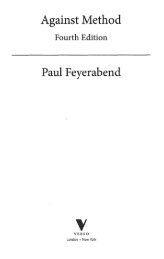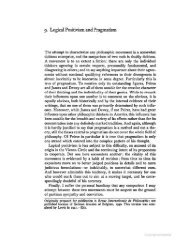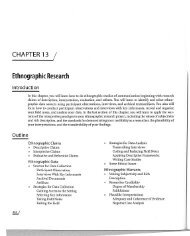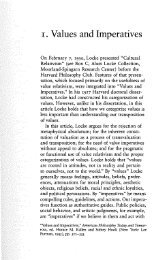In defence of the value free ideal
In defence of the value free ideal
In defence of the value free ideal
- No tags were found...
You also want an ePaper? Increase the reach of your titles
YUMPU automatically turns print PDFs into web optimized ePapers that Google loves.
EuroJnlPhilScitainties fully explicit and avoiding substantial inductive risks. 29 This is not to saythat <strong>the</strong> framework provided by <strong>the</strong> IPCC is perfect and flawless. <strong>In</strong> addition, I’mnot claiming here that <strong>the</strong> actual IPCC assessment reports consistently implement <strong>the</strong>Guidance Note and articulate uncertainties in a flawless way. But even if <strong>the</strong> guidingframework and <strong>the</strong> actual practice might be improved upon, <strong>the</strong> IPCC examplenone<strong>the</strong>less shows forcefully how scientists can articulate results as a function <strong>of</strong> <strong>the</strong>current state <strong>of</strong> understanding and <strong>the</strong>reby avoid arbitrary (methodological) choices.This effectively defeats <strong>the</strong> methodological critique <strong>of</strong> <strong>the</strong> <strong>value</strong> <strong>free</strong> <strong>ideal</strong>. 306ConclusionThe methodological critique <strong>of</strong> <strong>the</strong> <strong>value</strong> <strong>free</strong> <strong>ideal</strong> is ill-founded. <strong>In</strong> a nutshell, <strong>the</strong>paper argues that <strong>the</strong>re is a class <strong>of</strong> scientific statements which can be considered—for all practical purposes—as established beyond reasonable doubt. Results to <strong>the</strong>effect that, e.g., dinosaurs once inhabited <strong>the</strong> earth, alcohol <strong>free</strong>zes if sufficientlycooled, or methane is a greenhouse gas are not associated with decision makingrelevant uncertainties. Frequently, <strong>of</strong> course, empirical evidence is insufficient toestablish hypo<strong>the</strong>ses equally firmly. But ra<strong>the</strong>r than reporting uncertain results, andmanaging <strong>the</strong> ensuing inductive risks, scientific policy advice may set forth hedgedhypo<strong>the</strong>ses that fully make explicit <strong>the</strong> lack <strong>of</strong> understanding. By sufficiently weakening<strong>the</strong> reported results, it is always possible that scientific policy advice onlycommunicates virtually certain (hedged) findings. That’s what <strong>the</strong> methodologicalcritique <strong>of</strong> <strong>the</strong> <strong>value</strong> <strong>free</strong> <strong>ideal</strong> seems to underestimate.29 One may raise <strong>the</strong> question whe<strong>the</strong>r, by recommending use <strong>of</strong> expert judgement and surveys <strong>of</strong> expertviews, <strong>the</strong> Guidance Note in fact tolerates non-epistemic <strong>value</strong> judgements and represents, accordingly, acounterexample to this paper’s line <strong>of</strong> thought. The relation between expert judgements and non-epistemic<strong>value</strong> judgements is intriguing and clearly deserves closer attention. At this point, however, we have to becontent with <strong>the</strong> following brief remarks: First <strong>of</strong> all, <strong>the</strong> Guidance Note prescribes to use expert surveys inorder to gauge <strong>the</strong> degree <strong>of</strong> agreement within <strong>the</strong> scientific community (cf. Mastrandea et al. 2010, pp. 2–3), e.g. with a view to probability estimates. Such surveys hence represent one way to make <strong>the</strong> prevailinguncertainties explicit, fully in line with this paper. Secondly, I take it that to infer a hypo<strong>the</strong>sis from expertjudgement is not necessarily more uncertain than a well-founded inference from empirical evidence: <strong>In</strong>cases where we know that experts have acquired tacit knowledge and where many experts agree, expertjudgement, too, can establish a hypo<strong>the</strong>sis beyond reasonable doubt. Finally, whenever <strong>the</strong>se conditionsaren’t met, i.e. whenever expert judgement doesn’t establish a hypo<strong>the</strong>sis beyond reasonable doubt, <strong>the</strong>Guidance Note (in my understanding) recommends to switch <strong>the</strong> category, e.g.: if experts don’t agree on arange <strong>of</strong> a variable (category D), one should attempt to provide an order <strong>of</strong> magnitude (category C) ra<strong>the</strong>rthan reporting an uncertain and poorly founded quantitative range; if experts don’t agree on a probability<strong>of</strong> variable (category E), <strong>the</strong>y should try to estimate a range <strong>of</strong> possible <strong>value</strong>s for that variable withoutassigning probabilities. So, on <strong>the</strong> one hand, <strong>the</strong> Guidance Note can be interpreted in a way such that itremains an example for how to eliminate non-epistemic <strong>value</strong> judgements, although it relies on expertviews. On <strong>the</strong> o<strong>the</strong>r hand, <strong>the</strong> unspecific reference to expert judgements in <strong>the</strong> Guidance Note leaves roomfor different interpretations. Note, however, that this brief case study does not hinge on <strong>the</strong> Guidance Notebeing perfect or flawless in every single aspect, for it illustrates in any case <strong>the</strong> general methodologicalstrategy <strong>of</strong> removing policy-relevant inductive risks through making uncertainties explicit.30 The Guidance Note, by <strong>the</strong> way, endorses that <strong>ideal</strong> explicitly (cf. Mastrandea et al. 2010, p.2).






